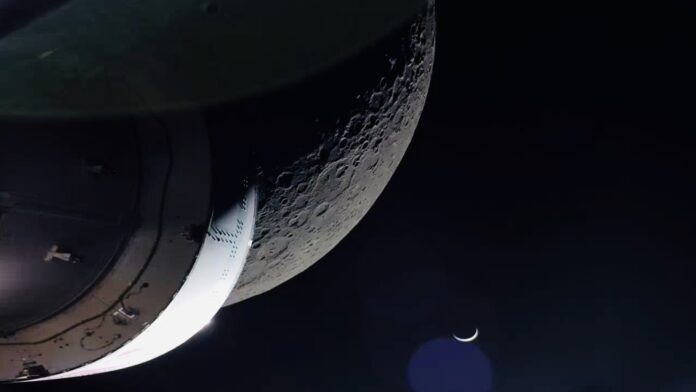NASA’s Artemis I mission is now returning to Earth after completing a flyby of the Moon that brought the spacecraft a mere 80 miles above the lunar surface.
The close flyby allowed the Orion capsule to record several stunning images of the Moon and its cratered surface. To initiate the flyby, the uncrewed Orion craft used its main engine to burn fuel for 3 minutes and 27 seconds for its final major maneuver.
The craft then crossed directly behind the Moon, causing NASA to briefly lose its radio signal with Orion. But about 30 minutes later, the capsule re-established contact while sending a Hollywood-esque image of the spacecraft heading back to Earth.
“This is the Earth rise that we witnessed,” said(Opens in a new window) Mike Sarafin, Artemis I mission manager, in a briefing. “Orion is in the foreground, the Earth is in the distant background and the Moon is in the middle there. You see a crescent Earth.”
(Credit: NASA)
NASA performed the flyby to harness the Moon’s gravity to “slingshot” the Orion spacecraft back to the Earth. The capsule is now scheduled to re-enter our planet’s atmosphere on Dec. 11, when it’ll make a splashdown in the Pacific Ocean.
“When Orion re-enters Earth’s atmosphere in just a few days, it will come back hotter and faster than ever before—the ultimate test before we put astronauts on board,” says NASA Administrator Bill Nelson.
Recommended by Our Editors
Artemis I represents NASA’s latest effort to return humans to the Moon. It successfully launched the Orion capsule from Earth last month using NASA’s giant Space Launch System (SLS), the most powerful rocket currently in existence. Last week, the Orion capsule then traveled 268,563 miles away from our planet, or farther than any other spacecraft built for humans.
NASA plans on sending human crews for future Artemis missions. But the next Artemis II(Opens in a new window) mission likely won’t occur until 2023, with an Artemis III(Opens in a new window) moon landing set for 2025. In the meantime, the public can track the current progress of the Artemis I mission through NASA’s dedicated website(Opens in a new window).
Get Our Best Stories!
Sign up for What’s New Now to get our top stories delivered to your inbox every morning.
This newsletter may contain advertising, deals, or affiliate links. Subscribing to a newsletter indicates your consent to our Terms of Use and Privacy Policy. You may unsubscribe from the newsletters at any time.
Hits: 0

















